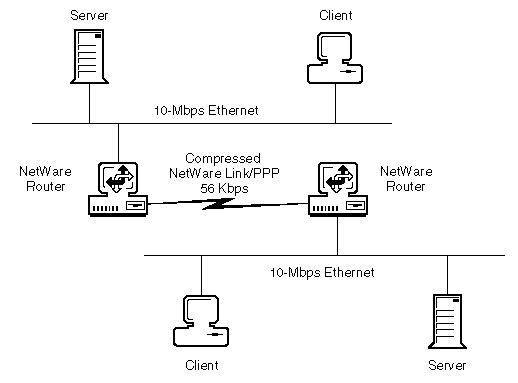

  |
NetWare Link/PPP supports compression of either the data or the header field of the Point-to-Point Protocol (PPP) packet. Both cannot be enabled at the same time because PPP data compression uses fields that are usually deleted by PPP header compression. With either method, you can also use Internetwork Packet ExchangeTM (IPXTM ) header compression or TCP/IP header compression for further optimization.
This topic contains the following sections:
When you select data compression, you are specifying that you want data to be transmitted in a more compact form. Using data compression has the following effect:
NOTE: When you enable data compression, it is used only if both the local and remote peers support a common compression technique. The Control Compression Protocol (CCP) handles the negotiation and selection of a common data compression protocol between systems. NetWare Link/PPP supports the Pattern Predictor algorithm, as well as other CCP-compliant data compression algorithms. Note that the Novell Internet Access Server 4.1 routing software maintains backward compatibility with NetWare MultiProtocol RouterTM 3.1 PPP data compression if the PTFs are installed. PPP data compression is not compatible with NetWare MultiProtocol Router 2.11 or 3.0.
By default, PPP does not guarantee data integrity. Retransmission of lost or corrupted data is the responsibility of higher-level protocols. However, when CCP successfully negotiates data compression, a reliable data-link protocol replaces the unreliable PPP data link to ensure the integrity of the compressed data exchange. This reliable data-link protocol is the International Telecommunication Union (ITU) Link Access Protocol-Balanced (LAPB). LAPB significantly increases the reliability of the communications link when used in conjunction with rigorous error checking after the received data is uncompressed.
Most data compression algorithms do not permit data corruption on the communications link because each bit of the compressed data is much more significant than the uncompressed data. One incorrect bit can result in thousands of bytes of incorrect output. This, in turn, results in retransmission requests and lower overall throughput.
Data compression is performed on network data only. NetWare Link/PPP Link Control Protocol (LCP) and Network Control Protocol (NCP) data is passed uncompressed. LCP and NCP data exchanges are used for connection management and configuration negotiation. They are typically used only during the connection establishment and termination operations.
NetWare Link/PPP supports the Pattern Predictor algorithm, as well as other CCP-compliant data compression algorithms. The Pattern Predictor compression technique provides useful data compression over a wide range of line speeds, from 1,200 baud through E1 data rates. Future versions of NetWare Link/PPP might include additional compression algorithms tailored to provide higher compression at specific line speeds.
Figure 5 illustrates a simple network configuration in which NetWare Link/PPP is operating over a 56-Kbps leased-line interface to connect two Ethernet LANs operating at 10 Mbps. Note that data compression is necessary only over the PPP link connecting two LANs, because this link is the slowest portion of the end-to-end network traffic.
Figure 5
PPP Data Compression for LAN-to-LAN Routing
When you use header compression, you are specifying that you want the following two fields in the header to be compressed:
Compressing these fields reduces PPP header overhead. Note, however, that enabling this compression does not guarantee that header compression is actually used. Header compression is negotiated when the link is established.
To configure data or header compression, complete the following steps:
Load NIASCFG, then select the following parameter path:
Select Configure NIAS > Protocols and Routing > Network Interfaces
Scroll to a configured PPP interface, then select it.
The PPP Network Interface Configuration menu is displayed.
Select PPP Negotiations Options .
The PPP Negotiations Options menu is displayed.
WARNING: Data and header compression cannot be enabled at the same time. PPP data compression uses fields that are usually deleted by PPP header compression.
Do one of the following:
If you are configuring header compression, select PPP Header Compression, then select Enabled.
This option specifies whether compression of the PPP Address and Control and PPP Protocol fields is enabled. PPP header compression is disabled by default.
Enabling this option does not guarantee that header compression is used. It indicates only that the local PPP interface attempts to negotiate its use.
If you are configuring data compression, do the following:
Select PPP Data Compression, then select Enabled .
This option specifies whether PPP data compression is used. PPP data compression is enabled by default.
NOTE: PPP data compression uses 150 KB of memory per port. If the router is short of memory, disable PPP data compression to decrease memory usage.
Enabling this option does not guarantee that data compression is negotiated with the remote peer. If the remote peer does not support compression, negotiation for the option fails, but the connection is still established.
If you are configuring data compression, select Preferred Compression Algorithm, then select the desired algorithm. The interface starts the compression algorithm negotiation process with the selected algorithm. However, the algorithm might not be used. If the selected algorithm is not supported by the peer router, negotiation continues until a common data compression algorithm is found. The default algorithm is Predictor II.
Press Esc to return to the Internetworking Configuration menu; save your changes when prompted.
If you want these changes to take effect immediately, select Reinitialize System .
If you want to configure other parameters, do so now, then reinitialize the system when you are finished.
  |